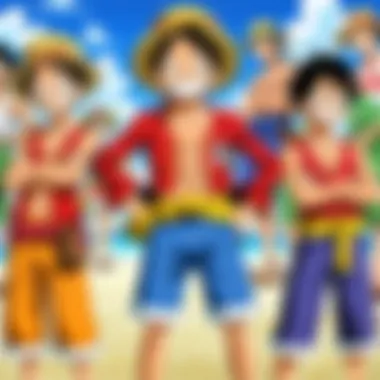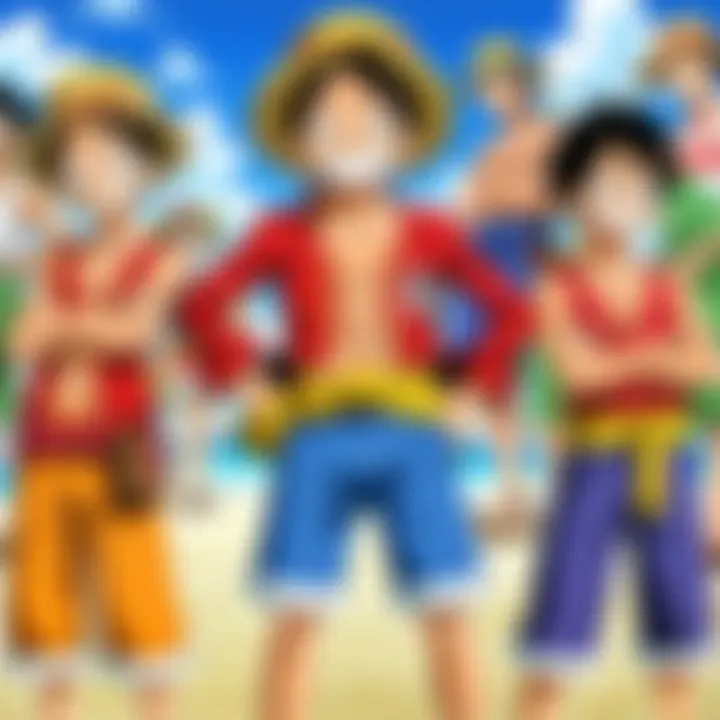Where to Stream 4Kids One Piece: Complete Guide


Intro
The realm of anime is vast, with classics often sparking spirited discussions. Among these, One Piece holds a special place, especially its 4Kids adaptation. While some purists may raise an eyebrow, there's an undeniable charm in how 4Kids shaped the series for a young American audience. It stands as a distinctive interpretation, blending laughs and adventure — fundamentally altering the narrative experience. For fans curious about where to watch this beloved edition, this guide endeavors to shine a light not just on the viewing platforms, but also on the cultural impact and legacy of the franchise.
This guide covers critical aspects: we will explore streaming options, delve into the series' unique take on the narrative, and present alternatives for those who want to experience the original Japanese episodes. Throughout, you'll find a treasure trove of insights aimed at enhancing your viewing experience.
Foreword to One Piece and its Adaptations
Understanding the world of One Piece goes beyond just its fascinating tales of adventure and camaraderie. The One Piece franchise, since its inception, has become a cornerstone in anime culture. Its adaptations, particularly the one produced by 4Kids, marked a pivotal moment in the history of anime localization for Western audiences. As a guide that aims to lead fans through the various ways to experience this iconic series, it’s important to delve into the various iterations of One Piece, particularly the 4Kids version, which has nuances and characteristics that set it apart from the original content.
Overview of One Piece
One Piece, created by Eiichiro Oda, is a saga that follows Monkey D. Luffy and his crew of pirates as they journey across the Grand Line in pursuit of the ultimate treasure, the One Piece. This series first hit the shelves as a manga in 1997 before transitioning to animation in 1999. It’s not just a tale of treasure hunting; it encapsulates themes of friendship, perseverance, and the unyielding pursuit of dreams. With its rich character development and intricate storytelling, One Piece has garnered a global fanbase, making it one of the longest-running and most beloved anime series.
One Piece is more than a single story—it's an expansive universe. Filled with countless arcs, each character adds depth to the narrative, embedding cultural references and moral lessons that resonate with a diverse audience.
The Role of 4Kids in Anime Localization
Back in the early 2000s, anime was relatively unknown in Western markets. This landscape changed considerably when One Piece was introduced in an adapted format by 4Kids Entertainment. This adaptation served as a bridge for many viewers, providing them access to a genre that may have otherwise remained unfamiliar.
4Kids took it upon themselves to adapt the series, making what they deemed necessary changes for American audiences. Although this approach has been subject to critique, it played a crucial role in anime shifting into a more mainstream acceptance in the US. They altered some content to make it less graphic, adjusted humor, and even modified character names. While some fans appreciate the effort to introduce anime to a new audience, others argue about the fidelity to the original work, leading to a complex relationship between the adaptation and content purists.
The Unique Characteristics of 4Kids One Piece
The 4Kids adaptation of One Piece stands out not just for its storytelling but also for how it reshaped many elements of the series to align with the expectations of a Western audience. This unique version of the anime brought both commendation and criticism, enlightening viewers on various facets of adaptation in anime. Understanding these distinctions is not just about nostalgia or preference; it's about recognizing how translations influence the perception and reception of foreign media.
Censorship and Content Alterations
One of the most notable aspects of the 4Kids version is the extensive censorship and content alterations that were employed. The creators took significant liberties in adapting the material, likely motivated by a desire to make the show suitable for children in the United States.
For instance, instances of violence were often toned down significantly. Characters might have been seen engaged in sword fights, but injuries were rarely depicted realistically; blood was removed, and instead of falling into a serious predicament, combatants might instead confront humorous outcomes or simply get up with a memory wipe.
Furthermore, certain themes that may seem innocuous in Japan were perceived as inappropriate for American viewers. This resulted in the removal or alteration of episodes where bar themes or elements like piracy were presented in a less than friendly manner. Such changes indicated a broader trend of censorship where cultural sensibilities met the need for content regulation in children’s programming. More often than not, this has led both to confusion and debate among fans questioning each adaptation's integrity.
Voice Acting Choices
Another strong feature of 4Kids' One Piece was its voice acting. The performances were undoubtedly aimed at infusing energy and a family-friendly vibe into the characters. However, these voice choices drew mixed reviews.
Take, for instance, the character of Monkey D. Luffy. In the 4Kids version, he is portrayed with a youthful exuberance that appeals to children, but this portrayal contrasts sharply with the original character's more layered personality. Some fans found the over-exaggerated styles to be detracting from the emotional depth that exists in the original.
This led to heated discussions among viewers and avid fans on platforms like Reddit where opinions varied widely. Some lauded the energy brought to the series, while others felt that the choice of such vocal styles oversimplified the complex emotions and growth that characters experience throughout the series. Mixing up the cast also resulted in new character chemistry that some enjoyed, while others found the original versions to be irreplaceable.
Cultural References and Adaptations
Cultural references and adaptations form another significant characteristic of the 4Kids One Piece series. Many of Japan's unique cultural elements were either modified or exchanged to cater to Western norms. For example, food items that would be commonplace in Japan may be swapped for more familiar fare in the United States.
The infamous "sake" frequently mentioned in the original was often referred to as "juice" or another child-friendly alternative, removing any adult connotations. Additionally, the humor and dialogue were adjusted to resonate more with an American audience, often leading to more lighthearted exchanges, sometimes at the expense of deeper narrative layers.
This adaptation approach sparked conversation among fans about the balance between localization and authenticity. While some viewers appreciated the accessibility this provided, others critiqued it for diluting the original message and charm of the source material.
"Cultural fidelity is a delicate dance; while one aims to reach new compansions, it’s critical not to lose the essence that made it a sensation in the first place."


In essence, the unique characteristics of the 4Kids adaptation of One Piece reflect a broader narrative surrounding localization in media. By examining these distinct features—censorship and alterations, voice acting, and the change of cultural references—viewers gain a deeper understanding of the challenges and considerations inherent in anime adaptation.
Where to Watch 4Kids One Piece
In the landscape of anime adaptations, 4Kids Entertainment's take on One Piece stands out like a lighthouse, guiding fans—new and old—through the seas of piracy, adventure, and friendship. Knowing where to watch this unique adaptation serves several purposes. It allows fans to relive the often silly yet endearing journey of Luffy and his pirate crew while also understanding the cultural nuances woven into the episodes. Additionally, by locating reliable viewing resources, fans can appreciate the differences that made this version a hot topic of discussion—not just among anime lovers, but among media analysts as well. In this section, we will delve into the various platforms available for viewing 4Kids One Piece, covering options from streaming services to physical media.
Streaming Services Offering 4Kids One Piece
When it comes to streaming, the internet has transformed how we consume entertainment. Fortunately, 4Kids One Piece is accessible on several platforms, each with unique offerings.
Crunchyroll
Crunchyroll is often seen as the go-to spot for anime lovers and rightly so. This service provides a wide range of titles, including the 4Kids version of One Piece. One key characteristic of Crunchyroll is its simulcast feature, meaning fans can watch episodes as they release in Japan. That said, with 4Kids, viewers get to see multiple episodes in one sitting, which can be a blessing or a curse, depending on your binge-watching habits. The most appealing aspect is the ability to add shows to your queue, keeping everything organized. However, potential downsides include ads if you opt for a free version, which can be distracting.
Hulu
Hulu is another platform where you can catch the 4Kids One Piece series. It brings not just episodes, but a vast library of TV shows and films. Hulu’s highlight is its user-friendly interface that allows viewers to navigate through categories effortlessly. They also bundle various streaming options, offering an expansive collection for its subscribers. One unique feature is its offline viewing option, allowing fans to download episodes for later. However, be mindful that Hulu may have limited availability for some episodes, which might require a bit of scavenger hunting.
Amazon Prime Video
Amazon Prime Video is a notable player in the realm of digital content, making it a viable option for those looking to watch 4Kids One Piece. One of its selling points is “purchase or rent” feature, letting you choose whether you want to own the episodes or just enjoy them temporarily. This flexibility can be beneficial for viewers who want to dip their toes in before deciding to buy. However, content availability can sometimes be a hit or miss, meaning not all episodes may be present at all times, which can frustrate dedicated fans.
Physical Media Options
For some, physical media offers a sense of nostalgia and connection that streaming simply can't replicate. The tactile experience of holding a DVD or downloading a file can enhance the viewing journey, making it more personal.
Collections
DVD collections remain a steadfast option for fans wanting to watch 4Kids One Piece. They often come packaged in stunning artwork, often appealing to collectors. DVDs typically present episodes in their intended format and offer supplemental materials, such as character bios and episode guides, which can offer deeper context. However, as technology moves forward, some may find the traditional DVD experience a bit clunky compared to streaming conveniences.
Digital Downloads
Digital downloads provide a modern route for watching One Piece. They offer the advantage of portability—allowing you to watch any where and anytime. Usually, platforms selling digital copies also offer tempting sales and bundles, which can be a win for budget-conscious fans. A drawback, though, is the dependency on device storage and connections; if your device is low on space or lacks internet access, that could hinder your viewing enjoyment.
Television Listings and Air Times
Although streaming dominates the viewing scene, television broadcasts still hold a cherished place in the hearts of many. When it comes to traditional air time, knowing when to tune in can be a game changer. Check local listings for channels that may carry reruns or special episodes of 4Kids One Piece. Make sure you mark your calendars; often, channels may change their lineups, making it essential to stay updated on schedules. Watching episodes live can also spark conversations with fellow viewers, making the experience all the more communal.
Comparative Analysis: 4Kids vs. Original Japanese Version
Understanding the differences between the 4Kids adaptation of One Piece and the original Japanese version is vital for anime enthusiasts. This comparative analysis not only sheds light on the varying storytelling and creative choices but also reflects on the broader implications of localization in anime. Each version weaves its own narrative tapestry, colored by cultural nuances, censorship choices, and artistic interpretations.
Anime fans often have strong opinions about how adaptations change source material. These discussions often spark debates on authenticity versus accessibility. Examining the variations in One Piece offers valuable insight into not only the series itself but also the zeitgeist of anime localization during its airing period in Western markets.
Storyline Modifications in 4Kids
When One Piece made its journey over to the West through 4Kids, several elements of the storyline saw notable changes. While the heart of the story remained, various narratives faced significant trimming or outright alterations. Generally, these edits aimed for a younger audience, focusing on humor and action while downplaying darker themes.
For example, the entire concept of smoking was heavily edited. Character habits involving cigars or cigarettes were replaced — often with items like lollypops, a move that showcased the aggressive censorship 4Kids adopted.
Moreover, entire story arcs faced cuts that removed adult themes, making the show feel somewhat sanitized. Take the scene where various characters engage in morally ambiguous actions. In the original version, these actions might have darker implications, whereas in 4Kids, consequences tended to be glossed over or modified entirely, leading to a more straightforward and less nuanced storytelling style.
Character Portrayals: A Dichotomy


The character portrayals in the two versions present a stark contrast. In the original Japanese version, characters often exhibit a depth that reflects their personal complexities and growth arcs. Conversely, the 4Kids adaptation simplifies many character traits, focusing on humorous catchphrases and relationships that might seem more superficial.
Take Zoro, for instance. In the original, he grapples with themes such as loyalty and honor, while 4Kids tends to create a more straightforward warrior persona focused primarily on action and catchphrases like, "I'm ready for battle!". Such choices lessen the emotional weight of their journeys, offering less substance and complexity.
Additionally, the voice acting further changes the perceptions of these characters. The energetic yet sometimes exaggerated performances lean towards appealing to a younger audience instead of capturing the scars and heart of the original performances.
Art and Animation Differences
Art and animation styles present yet another layer of divergence. The original One Piece is known for its unique character designs and vibrant animation that reflects various influences from the creator's artistic style. In contrast, 4Kids often toned down the color palettes and altered character designs, typically emphasizing more child-friendly aesthetics.
For instance, the original animation showcases dynamic battle sequences full of intensity and stylish flair, while the 4Kids version can feel more static or lack the same level of dramatic impact. The animation frames sometimes appear simplified, losing the intricate details that are hallmarks of One Piece.
In terms of art, while the original captures the whimsical and adventurous essence of the world, the adaptations often resorted to more generic designs that, while vibrant, tend to feel more like a cookie-cutter approach rather than a faithful representation of Oda's vision.
"A single frame can change the perception of an entire scene, and adaptations can often dilute those crucial moments that resonate with fans."
In concluding this analysis, one could argue that while the 4Kids version makes One Piece accessible for a younger audience, it ultimately alters the experience for those seeking the depth of the original story. This comparison continues to fuel dialogues among fans who weigh nostalgia against the alterations that marked the localization process.
The Cultural Impact of 4Kids One Piece
The 4Kids adaptation of One Piece has left a unique imprint on anime culture, particularly in the Western world. Many fans of the series often comment on how this version marked their introduction to anime. It played a pivotal role in making the genre more accessible to a broader audience. The blend of localized humor, alterations that fit Western sensibilities, and creative liberties taken by 4Kids made the show a controversial yet impactful adaptation of the original work.
Reception Among Western Audiences
When 4Kids initially aired its version of One Piece, the reception was mixed, to say the least. On one hand, the adaptation garnered a significant following among younger viewers who found the bright visuals and fast-paced storytelling captivating.
On the other hand, adult fans and purists of the original series critiqued the various changes made - from character designs to story arcs. Some innovations, such as the use of puns and comedic dialogue, engaged viewers, while others felt these modifications diluted the story's depth and themes. In some cases, character motivations were altered, leading to an audience who might have been well-disposed toward the original to feel disillusioned.
Despite the controversy, the legacy of the 4Kids adaptation remains. It is cited frequently on platforms like Reddit or various anime forums. Many claim that this show was their gateway into the larger world of anime, creating a community that, while divided in opinion, nevertheless came together over the shared experience of watching the show.
"4Kids One Piece was my first anime. It hooked me in, and later I discovered the original. I appreciate both for their own reasons."
Influence on Future Dubs and Adaptations
The influence of 4Kids One Piece on future anime dubs cannot be overstated. After their tenure, the blueprint they created for localized adaptations became a reference point for other shows. 4Kids set a precedent in understanding the balance between maintaining the essence of the original while making it appealing to Western audiences.
Some elements of their approach have arguably persisted in modern dubbing practices. Here's how:
- Localized Comedy: Many subsequent adaptations have adopted the use of localized humor, aiming to resonate with a culturally specific audience.
- Character Renaming: The trends established by 4Kids in changing character names have been mirrored in other adaptations, though often with less drastic alterations.
- Censorship Practices: The choices around content modifications inspired a pattern where newer dubs tread carefully around cultural sensitivities and real-world issues.
While the 4Kids adaptation might not be universally accepted as the definitive version of One Piece, its impact is tangible. It helped fashion a pathway for dialogue about anime localization, opening avenues for more nuanced adaptations that celebrated the original while engaging local audiences.
In uncovering its historical significance, one can confidently assert that 4Kids has played a crucial role in shaping the interaction between anime content and its diverse audiences across the globe.
Alternatives for One Piece Viewing
Exploring alternatives for watching One Piece allows fans to appreciate the series in various ways, ensuring a more profound understanding of its themes and cultural significance. While the 4Kids adaptation has left a notable mark, many enthusiasts wish to compare it with other versions, enriching their viewing experience. Whether it’s through original Japanese episodes or different adaptations, these alternatives provide access to the series' original charm and depth.
Streaming the Original Japanese Version
Funimation


Funimation stands out as a significant player in the anime streaming world. Known for its diverse library, it provides viewers access to the original Japanese One Piece episodes, complete with accurate subtitles and dubbing options. This ensures fans catch every nuance in storytelling that might be lost in localized adaptations.
One of the key characteristics of Funimation is its extensive editing and dedication to maintaining the series' authenticity. Fans appreciate that it offers a closer representation of the original material, allowing them to experience the emotional depths that the series promises. This is especially essential when contrasting different translations, as subbed versions often stick closely to the source material’s intent.
However, viewing through Funimation isn’t without its drawbacks. Some users may find its interface less user-friendly compared to other platforms. Also, availability can vary depending on geographical access, creating barriers for some audiences.
Crunchyroll
On the other hand, Crunchyroll is renowned for its user-engagement and an expansive catalog that appeals particularly to anime lovers. It streams a variety of One Piece episodes in Japanese with subtitles, presenting fans an unaltered version that resonates more with the original creators’ vision.
One unique feature of Crunchyroll is its simulcast capability, allowing fans to follow episodes as they air in Japan, often within hours of their release. This feature makes it an ideal space for those who crave immediacy in content. Additionally, the community-building aspects of Crunchyroll, such as forums and groups, foster an environment for discussion and sharing insights, enhancing the collective experience surrounding One Piece.
Despite its advantages, Crunchyroll can also present challenges. Viewers may occasionally encounter ad breaks, which can interrupt immersion. Moreover, the availability of the entire library may be limited based on subscription tiers, leaving some viewers yearning for episodes.
Exploring Other Adaptations
Subtitled Versions
Subtitled versions of One Piece have made strides in bridging the gap between original intent and Western audiences. These adaptations often strive to retain the original dialogue's tone while making it accessible. Their benefit lies in a more straightforward approach, allowing viewers to follow along without the distractions of dubbing.
The key characteristic of these subtitled versions is their fidelity to the source material. They preserve the integrity of the characters’ voices and prose, enabling fans to form their interpretations of the story. Such versions can sometimes provide cultural nuances that English dubbing might oversimplify.
However, subtitled content does have its downsides. Some viewers, especially those not familiar with reading subtitles, may find it challenging to keep up with the fast-paced dialogue. This could deter new fans who aren’t accustomed to this viewing approach.
Different Dubbing Companies
As an alternative, exploring different dubbing companies offers a rich spectrum of interpretations of One Piece. Various studios have approached the content differently, appealing to diverse audience segments. This variability allows fans to experience alternative performances of beloved characters, enhancing engagement with the storyline.
One salient aspect of these companies is that they bring unique voices and interpretations, sometimes leading to different comedic or dramatic spins on familiar moments. This flexibility can draw in viewers who may prefer varying styles of expression and voice acting.
While these alternative dubs are enjoyable, they might not always capture the intended essence of the original. Different studios might alter character motivations or dialogues for localization purposes, leaving viewers with a sense of disconnect compared to the source material. Furthermore, the inconsistency in quality among dubbing companies may lead to varying viewer experiences.
"Exploring alternatives for watching One Piece translates to a richer understanding of the anime's cultural and narrative landscapes. Choosing the right method can make all the difference."
In summary, whether venturing into original Japanese versions via streaming services like Funimation or Crunchyroll or considering different adaptations and dubbing choices, these alternatives expand the horizons for One Piece fans. Each option provides unique benefits and challenges, allowing viewers to personalize their journey through the Grand Line.
Final Thoughts on 4Kids One Piece
The 4Kids adaptation of One Piece holds a distinctive position in the larger narrative landscape of anime. This section delves into its significance, highlighting elements that inform our understanding of this series, its place within anime history, and the legacy it continues to leave behind.
Evaluating Its Place in Anime History
When looking back, the role of 4Kids in American anime distribution seems like a double-edged sword. On one hand, their efforts brought One Piece to a broader audience, making it accessible to kids who might not have otherwise engaged with anime. However, the edits, notably in humor and themes, sparked significant debates among hardcore fans and critics alike.
As a consequence of their localization strategy, 4Kids altered narratives to fit what they viewed as America's cultural sensitivities. This can be seen as both a positive and a negative, depending on individual perspectives. Admittedly, many youngsters were introduced to the world of pirates and adventure through this version, but purists have often questioned the series' integrity.
The impact, therefore, is twofold: it was crucial for mainstream exposure yet often perceived as a dilution of the original creativity found in One Piece. Today, fans remember this adaptation as a pivotal moment—the series might not have reached American shores at all without 4Kids, but the character alterations may have influenced how future adaptations were produced.
The Ongoing Legacy of One Piece
Even years after its broadcast, the legacy of 4Kids’ One Piece can be felt deeply within the anime community. Many fans retain fond memories, viewing the series through the lens of their childhood. Beyond nostalgia, it has inspired a myriad of discussions on online forums and platforms like reddit.com, where users analyze its content, share experiences, and dissect its impact on their lives.
The 4Kids version also played a role in shaping discussions around censorship and adaptation methods in anime. This adaptation opened the doors for future localization companies to revisit their approaches. In a world that increasingly values authenticity, adaptations are now more aware of the need to balance local appeal with the original's essence. As a result, contemporary adaptations tend to retain closer ties to the source material.
"In looking back at 4Kids’ One Piece, we not only see a beloved adventure but also a key chapter in Islamic history and cultural exchange within the anime genre."
To sum it up, the impact of 4Kids’ relevance in the anime sphere cannot simply be brushed off. It serves as a lesson in adaptation and localization, and continues to provoke thought for both creators and audiences. The legacy of One Piece, in all its forms, remains multi-faceted, reminding us of the complexities of storytelling across cultures. With countless discussions still buzzing in the community, one thing is clear: 4Kids, while perhaps imperfect, sparked a conversation that endures.
Thus, as we reflect on 4Kids’ One Piece, we find an intriguing integration of culture, nostalgia, and evolution in storytelling that permanently etched its mark in the annals of anime history.







